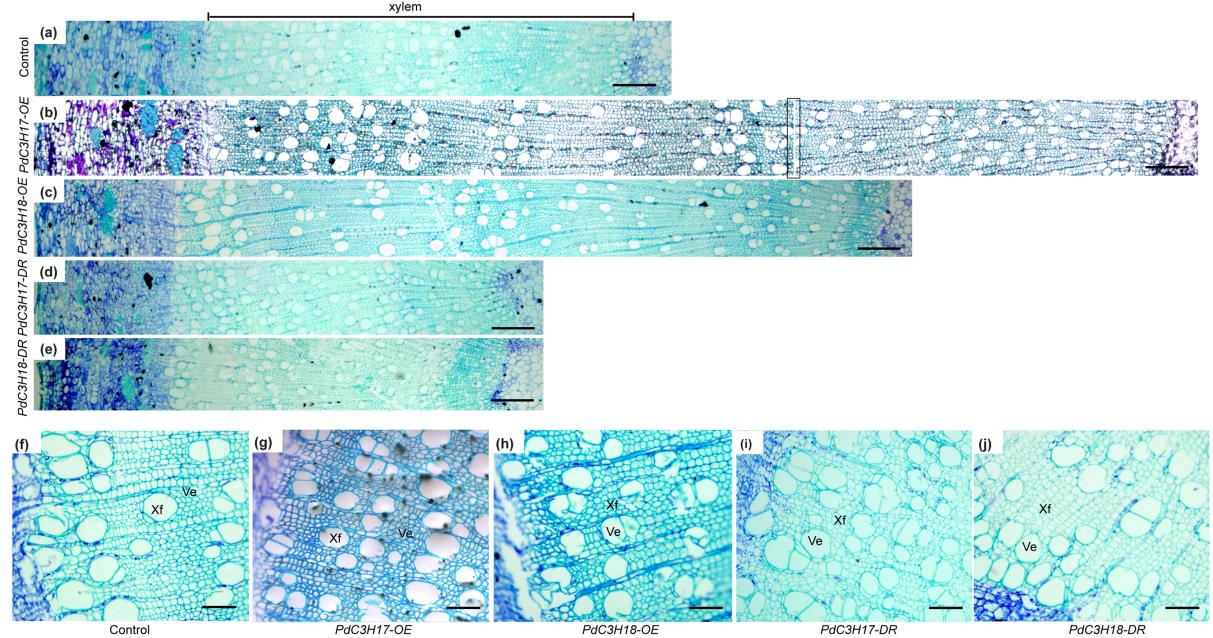
QIBEBT Reveals Molecular Mechanisms of PdC3H17 and PdC3H18 Regulating Secondary Wall Formation in Poplar
May 22, 2014 Email"> PrintText Size

Poplar has many advantages as a tree model for woody plant biology. These include rapid and perennial growth, moderate genome size, biomass-related traits and relatively easy transformation. However, the molecular mechanisms underlying secondary wall formation remain elusive in poplar. Energy Plant Group in Qingdao Institute of Bioenergy and Bioprocess Technology, Chinese Academy of Sciences (QIBEBT) has firstly reported the molecular mechanism of PdC3H17 and PdC3H18 regulating secondary wall formation in poplar and Arabidopsis. This work was published in New Phytologist (Chai, et al, New Phytologist, 2014).
Before this, the research team has revealed poplar PdC3H17 and PdC3H18 are specifically expressed in stems, suggesting they may be involved in secondary wall formation (Chai, et al, BMC Genomics, 2012). In this new work, Dr. CHAI Guohua and co-workers further explored the molecular mechanism of PdC3H17 and PdC3H18 regulating secondary wall formation. They used multiple methods, including electrophoretic mobility shift assay (EMSA) and transgene, to demonstrate that PdC3H17 and PdC3H18 are direct targets of PdMYB3 and PdMYB21, and promote stem cambium activity and positively regulate secondary wall formation. The results in this project will provide the theoretical basis for genetic engineering tree secondary cell walls.
This work was led by Prof. ZHOU Gongke and granted by National Science and Technology Support Program, the National Basic Research Program of China, and the National Natural Science Foundation of China.

Figure. Effects of overexpression or dominant repressors of PdC3H17 and PdC3H18 on xylem development in poplar. (a–e) Microscopic analyses of basal stem sections of representative 6-month-old control, PdC3H17-OE, PdC3H18-OE, PdC3H17-DR and PdC3H18-DR plants, showing the relative distribution of the xylem. (f–j) Close-up view of cell wall thickness in xylary fibers and vessels showing that cell wall thickening in xylem is positively regulated by PdC3H17 and PdC3H18. Xf: xylary fiber; ve: vessel. Bars: (a–e) 200 lm, (f–j) 50 lm. (Image by Energy Plant Group, QIBEBT)
Contact:
Prof. ZHOU Gongke
Energy Plant Group, Qingdao Institute of Bioenergy and Bioprocess Technology, Chinese Academy of Sciences
E-mail: Zhougk (AT) qibebt.ac.cn
Poplar has many advantages as a tree model for woody plant biology. These include rapid and perennial growth, moderate genome size, biomass-related traits and relatively easy transformation. However, the molecular mechanisms underlying secondary wall formation remain elusive in poplar. Energy Plant Group in Qingdao Institute of Bioenergy and Bioprocess Technology, Chinese Academy of Sciences (QIBEBT) has firstly reported the molecular mechanism of PdC3H17 and PdC3H18 regulating secondary wall formation in poplar and Arabidopsis. This work was published in New Phytologist (Chai, et al, New Phytologist, 2014).
Before this, the research team has revealed poplar PdC3H17 and PdC3H18 are specifically expressed in stems, suggesting they may be involved in secondary wall formation (Chai, et al, BMC Genomics, 2012). In this new work, Dr. CHAI Guohua and co-workers further explored the molecular mechanism of PdC3H17 and PdC3H18 regulating secondary wall formation. They used multiple methods, including electrophoretic mobility shift assay (EMSA) and transgene, to demonstrate that PdC3H17 and PdC3H18 are direct targets of PdMYB3 and PdMYB21, and promote stem cambium activity and positively regulate secondary wall formation. The results in this project will provide the theoretical basis for genetic engineering tree secondary cell walls.
This work was led by Prof. ZHOU Gongke and granted by National Science and Technology Support Program, the National Basic Research Program of China, and the National Natural Science Foundation of China.
|
|
| Figure. Effects of overexpression or dominant repressors of PdC3H17 and PdC3H18 on xylem development in poplar. (a–e) Microscopic analyses of basal stem sections of representative 6-month-old control, PdC3H17-OE, PdC3H18-OE, PdC3H17-DR and PdC3H18-DR plants, showing the relative distribution of the xylem. (f–j) Close-up view of cell wall thickness in xylary fibers and vessels showing that cell wall thickening in xylem is positively regulated by PdC3H17 and PdC3H18. Xf: xylary fiber; ve: vessel. Bars: (a–e) 200 lm, (f–j) 50 lm. (Image by Energy Plant Group, QIBEBT) |
Contact:
Prof. ZHOU Gongke
Energy Plant Group, Qingdao Institute of Bioenergy and Bioprocess Technology, Chinese Academy of Sciences
E-mail: Zhougk (AT) qibebt.ac.cn
CAS Institutes
There are 124 Institutions directly under the CAS by the end of 2012, with 104 research institutes, five universities & supporting organizations, 12 management organizations that consist of the headquarters and branches, and three other units. Moreover, there are 25 legal entities affiliated and 22 CAS invested holding enterprisesThere are 124 I...>> more
Contact Us

Chinese Academy of Sciences
Add: 52 Sanlihe Rd., Xicheng District, Beijing, China
Postcode: 100864
Tel: 86-10-68597592 (day) 86-10-68597289 (night)
Fax: 86-10-68511095 (day) 86-10-68512458 (night)
E-mail: cas_en@cas.cn

